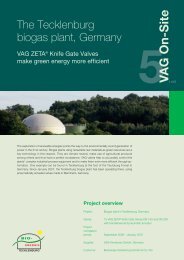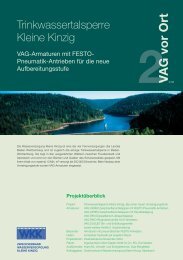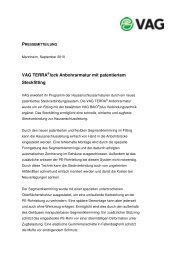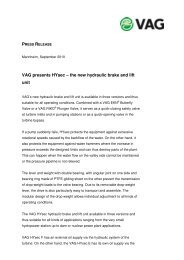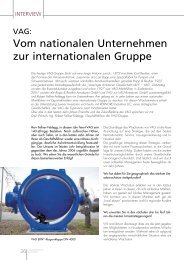Create successful ePaper yourself
Turn your PDF publications into a flip-book with our unique Google optimized e-Paper software.
Water from the world's<br />
first cave power station<br />
on Java, Indonesia<br />
V<strong>AG</strong> valves supply water from the<br />
caves under the 'thousand hills' 11<br />
Yogyakarta Special Province is one of the poorest areas of Java and Indonesia mainly<br />
because of the extreme lack of water. A dry season lasting several months and the craggy<br />
karst soil means that harvests are poor and drinking water scarce. In the 1980s, a ramified<br />
cave system with underground rivers was discovered 100 metres below the karst plateau. All<br />
that was needed was a sustainable way of exploiting the source.<br />
A German-Indonesian cooperative was put in place in 2000. The goal of this interdisciplinary<br />
cooperation between researchers, scientists, corporations and institutes was to tap into and<br />
exploit the available water resource.<br />
Project overview<br />
Project: Cave power plant<br />
V<strong>AG</strong> <strong>On</strong>-<strong>Site</strong><br />
Valves: V<strong>AG</strong> EKN ® Butterfly Valve, PN 10, DN 800<br />
with baseplate and bedplate, insulating plate,<br />
worm gear and AUMA electric actuator<br />
Installation: June 2008<br />
V<strong>AG</strong> RIKO ® Plunger Valve DN 600/700<br />
with baseplate and bedplate, insulating plate,<br />
worm gear and AUMA electric actuator<br />
V<strong>AG</strong> dismantling joints DN 600 and DN 800<br />
Customer: University of Karlsruhe, Germany, Institute for,<br />
water management and hydraulic engineering<br />
10/08
Water from the world's first<br />
cave power station on Java, Indonesia<br />
This unique pilot project in the Gua<br />
Bribin cave was managed by Prof Dr<br />
Franz Nestmann together with Dr<br />
Peter Oberle, project coordinator at<br />
IWG (Institute for Water and River<br />
Basin Management at the University<br />
of Karlsruhe).<br />
'Over 1000 litres of water a second<br />
flow through the Gua Bribin cave even<br />
in the dry season. It’s the perfect place<br />
to build a dam,' explains Dr Peter<br />
Oberle from IWG.<br />
The plan was to control the retained<br />
water with a V<strong>AG</strong> RIKO Plunger Valve<br />
and a V<strong>AG</strong> EKN Butterfly Valve.<br />
But before the plan could be executed,<br />
the widely ramified cave system<br />
had to be studied and measured. And<br />
there were adventures with the indigenous<br />
fauna that needed to be<br />
lived…<br />
In December 2004, Herrenknecht<br />
completed the 100 metre long access<br />
tunnel it built with its new vertical boring<br />
machine.<br />
The work on the underground dam<br />
could finally begin. Progress was,<br />
however, slowed down considerably<br />
by events such as the catastrophic<br />
earthquake in 2006, floods and a<br />
rockfall.<br />
The work was finally completed in<br />
June 2008, and the site was ready<br />
for the V<strong>AG</strong> valves. The tension<br />
increased when the valves arrived at<br />
the entrance of the supply tunnel:<br />
'Getting the valves into the tunnel was<br />
a challenge in itself,' reports Werner<br />
Helm, the team's master-builder.<br />
'The very heavy Plunger Valve had to<br />
be lowered 100 metres into the<br />
ground through the supply tunnel.'<br />
<strong>On</strong>ce in place, a baseplate and bedplate<br />
with cement anchors were used<br />
to stabilize the V<strong>AG</strong> RIKO Valve,<br />
which is equipped with an electronic<br />
AUMA control actuator that is powered<br />
by the electricity generated at the<br />
site. A venting system with DIN 250<br />
venting port ensures the valve operates<br />
without cavitation.<br />
Contact for this project is Thomas Laabs, Gaiberg, T.Laabs@vag-armaturen.com<br />
V<strong>AG</strong>-Armaturen GmbH · Carl-Reuther-Strasse 1 · 68305 Mannheim, Germany · Phone +49 621 7 49-0<br />
Fax +49 621 7 49-21 53 · www.vag-armaturen.com · info@vag-armaturen.com<br />
V<strong>AG</strong> <strong>On</strong>-<strong>Site</strong><br />
11<br />
The water pressure now powers turbines<br />
that are connected by a drive to<br />
KSB feed pumps that press part of<br />
the water 200 metres up into a reservoir.<br />
'The flood test at the end of June<br />
2008 was the straw that could have<br />
broken the camel’s back', says Dr<br />
Peter Oberle. 'But it was successful!<br />
We know that the cave will hold the<br />
water and that we can achieve the<br />
required storage level of 15 metres.'<br />
The detailed scientific documentation<br />
of the extensive research and construction<br />
work is available at<br />
www.hoehlenbewirtschaftung.de.<br />
'We're extremely happy this model<br />
project was completed successfully',<br />
says a happy Professor Nestmann.<br />
'We can now apply what we learned<br />
to every karst region in the world, like<br />
Sri Lanka, Thailand and Laos.'







